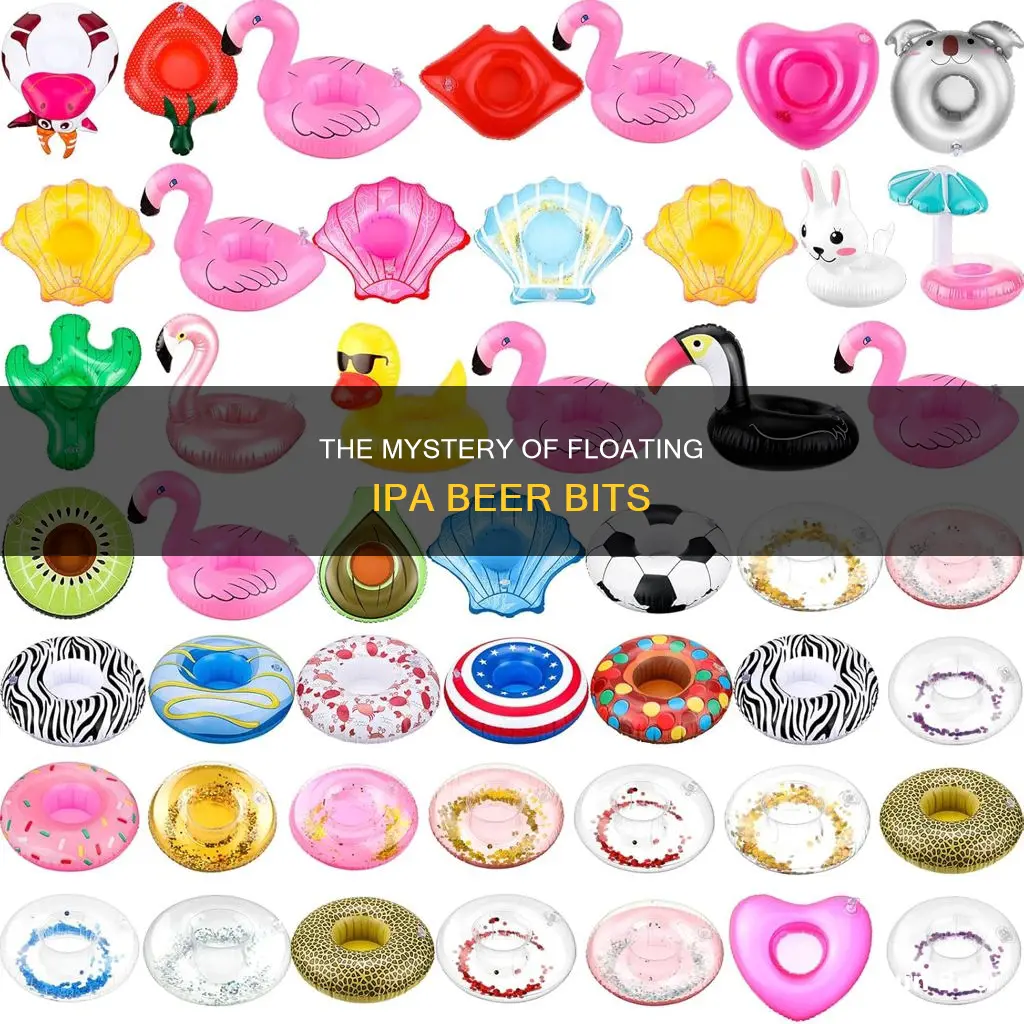
If you've ever noticed little chunks floating in your IPA beer, you may be wondering what they are and whether they're safe to drink. These floaters are usually harmless and are the result of either yeast settling, protein clumps, or sediment, which can occur when beer is unfiltered or unpasteurized. While they may not look appetizing, these floaties won't impact the taste of your beer and are safe to consume. However, drinking the sediment may cause some digestive discomfort for some people. So, the next time you see those little floaters in your IPA, you can choose to drink up or pour slowly and carefully to avoid them—the choice is yours!
| Characteristics | Values |
|---|---|
| Type | Sediment, dead yeast, protein |
| Composition | Polyphenol-protein complex (PPC), hop protein clumps |
| Appearance | Flakes, chunks, blobs, flecks, haze |
| Taste | Unchanged |
| Safety | Safe to drink |
What You'll Learn

Sediment in beer
Some beers, particularly IPAs and other hoppy brews, may form hop protein clumps over time. These clumps can give the beer a cloudy or hazy appearance and are generally considered harmless. However, haze caused by protein precipitation can sometimes affect the flavour of the beer and provide a feeding ground for unwanted bacteria.
To avoid consuming sediment, it is recommended to pour the beer slowly and carefully into a glass. Allowing the beer to sit in the fridge for a while can also help settle the sediment at the bottom of the bottle or can. Checking the beer against a bright light can help identify the presence of sediment or floaties before consumption.
While sediment in beer may be unappetizing, it is important to note that it is usually harmless and does not affect the safety of the beverage. However, if the beer has been exposed to direct sunlight or high temperatures for extended periods, it may develop cultures or infections that can impact its taste and quality.
Breweries may choose to package their beers unfiltered, prioritizing the retention of the full array of hop compounds, B vitamins, and other nutrients. This decision can result in cosmetic blemishes, such as sediment or floaties, but some consumers prefer the unfiltered option for its perceived health benefits and fuller flavour profile.
Michelob Ultra: An IPA Beer or Not?
You may want to see also

Sediment being a polyphenol-protein complex (PPC)
Sediment in beer is primarily composed of protein particles resulting from the brewing process. Sedimentation occurs when polyphenols from hops interact with proteins from malt, creating a polyphenol-protein complex (PPC). This complex is a natural occurrence in beer, particularly in those that are unfiltered, such as IPAs and other hoppy brews.
The formation of PPCs is a result of the cross-linking of haze-active (HA) proteins and HA polyphenols. HA proteins and polyphenols have multiple binding sites, allowing them to form polymers that cause turbidity in beer. The stability of beer haze depends on the proportion of HA proteins and polyphenols present. When there is an excess of HA proteins, most HA polyphenols form dimers, resulting in particles that are too small to cause haze. Conversely, when HA polyphenols are in excess, they cannot form large enough cross-links to cause turbidity. Turbidity occurs when the total concentration of polyphenol ends is roughly equal to the number of binding sites in the proteins, resulting in the formation of large colloidal particles that scatter light.
The presence of sediment in beer is not an indication of spoilage or negative trait. In fact, sediments are acceptable and even desirable in many beer styles, such as German Hefeweizen, New England IPA, and bottle-conditioned beers. While these sediments may affect the presentation of the brew, they are safe for consumption and do not alter the taste.
Guinness Beer: Alkaline or Acidic Drink?
You may want to see also

Sediment being dead yeast
Sediment in beer is usually yeast and protein particles that are left over from the brewing process. In the case of IPAs, the sediment is most likely dead or dormant yeast cells. These yeast cells are used for carbonation and are supposed to be in the beer.
In bottle-conditioned beers, a small amount of active yeast and simple sugars are added to the bottle before sealing it. This process allows the beer to naturally carbonate and increase its alcohol content. After the yeast has finished carbonating the beer, the yeast cells clump together and fall to the bottom of the bottle, creating a thin cake layer. If the bottle is agitated, these yeast particles are stirred up and will appear as sediment in the beer.
Bottle-conditioned beers are safe to consume and are often recommended by brewers. In some styles of wheat beer, the yeast also enhances the flavour, making the beer taste spicier. This is the case with German-style wheat beer hefeweizen.
To avoid sediment in your beer, store the bottle upright so that the sediment can settle at the bottom. When it is time to serve, gently pour about two-thirds of the beer into a glass, then carefully tilt the bottle towards the glass, pouring the rest of the liquid until you see the sediment approach the lip of the bottle. By doing this, you will only lose about a sip of beer, but your drink will be as clear as possible.
India's IPA Beer: A Cultural Fusion
You may want to see also

Sediment being harmless protein blobs
Sediment in beer is usually harmless and mostly yeast. In some cases, it's yeast and protein particles. The presence of sediment in beer depends on the style of beer and the brewing process.
Sediment in beer is mostly composed of yeast, which is left over from the conditioning process. Bottle conditioning is when a small amount of active yeast and simple sugars are added to the bottle before sealing it. This allows the beer to naturally carbonate and increase the alcohol content. After fermentation, yeast cells clump together and drop to the bottom, forming a thin cake. When the bottle is agitated, these particles are suspended in the beer, creating sediment.
In addition to yeast, protein particles can also form sediment in beer. This is more common in beers that are unfiltered and have a high protein content, such as German Hefeweizen, New England IPA, and wheat beers. The proteins clump together and either float inside the liquid or settle at the bottom. This can give the beer a cloudy or hazy appearance.
While sediment in beer is usually harmless, it can sometimes indicate that the beer is old or past its prime. In these cases, the proteins in the beer will clump together and float inside the liquid, resembling snowflakes. Additionally, the hop flavors may diminish, and the beer may taste stale, oxidized, or musty.
It's important to note that the presence of sediment in beer can be intentional and is not always a negative trait. In fact, some beer styles, such as Hefeweizen, are meant to have yeast mixed into the beer to complete the flavor profile. Sediment can also be the result of flavored or spiced beers, where the flavorings have settled out of the beer.
Overall, sediment in beer, especially in home-brewed or craft beers, is common and usually harmless. It is composed of yeast and protein particles and can be intentionally left in the beer to enhance the flavor or appearance. However, in some cases, it may indicate that the beer is old or contaminated.
Guinness Beer: Carbonation Secrets Revealed
You may want to see also

How to spot a bad beer
So, you've poured yourself a beer and notice some little things floating in it. Are they harmless or has your beer gone bad?
First of all, if you notice any floaties in your beer, don't panic. They might look like blobs of protein or yeast chunks, but they are usually harmless. In fact, some breweries choose to package their beer unfiltered, which can result in these cosmetic blemishes. This decision is based on the belief that leaving the beer unfiltered preserves the full array of hop compounds, B vitamins, and other nutrients. So, while it might not look very appetising, your beer is most likely safe to drink.
However, if you want to make sure your beer is in perfect condition, here are some signs that it has gone bad:
- Flatness: While some beers are meant to be flat, others rely on carbonation for their mouthfeel and taste. If a highly carbonated beer like an American-style light lager is flat, it's a sign of poor quality.
- Skunked flavour: This happens when beer is light-struck, usually due to ultraviolet light rays permeating clear or green bottles. To avoid this, buy beer in cans or brown bottles, and avoid beer that has been displayed under harsh lighting.
- Oxidation: When beer is exposed to oxygen, it starts to oxidise and go stale. It might taste like cardboard or envelopes, or even like leather or sherry if heavily oxidised.
- Infection: This is when your beer tastes like vinegar or rotten vegetables. It's caused by contamination during the brewing process or dirty beer lines.
- Trichloroanisole (TCA): This chemical is released by fungi and can cause a "water taint" in beer. It has a musty, old building-like smell and taste.
- Dichlorophenol (TCP): This mixture of chemicals has a strong antiseptic odour and flavour. It's caused by reactions between chlorine compounds in cleaning chemicals and phenols naturally present in beer.
If your beer exhibits any of these signs, it's best to dump it and open a fresh one. Cheers!
Guinness Beer Alternatives: Exploring Dark and Delicious Brews
You may want to see also
Frequently asked questions
These are most likely sediment, which is mostly dead yeast. This is common in unfiltered beer.
Yes, it is normal for some beers to have floaters, especially unfiltered or unpasteurized craft beers.
Yes, the floaters are safe to drink and are even good for you. However, drinking a large amount of sediment may cause bloating or extra gas.
Beers that are unfiltered or unpasteurized are more likely to have floaters. Mainstream beer is usually pasteurized, so it doesn't change much once it's been bottled or canned.
To avoid getting floaters in your beer, always pour slowly into a glass. You can also check the bottom of the bottle with a bright light to look for sediment before pouring.







